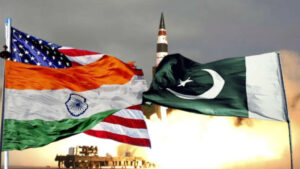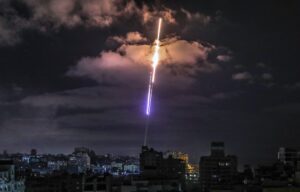By Shamil Abdullah
On April 13th, Iran launched an unprecedented strike on Israel with more than 300 drones, ballistic, and cruise missiles in the wake of Israel’s 1st April strike on the Iranian embassy complex in Damascus, Syria. The airstrike killed 16 people which included eight officers of the Islamic Revolutionary Guard Corps (IRGC) to which Iran vowed revenge. In the early hours of Friday 19th April, Israel retaliated in Iran’s central city of Isfahan. Both states have escalated their shadow conflict into a looming specter of direct confrontation. However, now it seems unlikely that the situation will escalate any further as both states have signaled reducing tension, and Israeli strikes are downplayed by Iran claiming that Israeli drones were intercepted by the Iranian missile defense system. The Iranian strike showcases a stark shift where relatively inexpensive weapons have been utilized against a well-equipped state. In this case, Israel reportedly spent between $500 million-$1 billion in resources to counter incoming drones, cruise missiles, and ballistic missiles launched by Iran. This event signifies a pivotal shift in the Revolution in Military Affairs, underscoring the potential for escalation to exert pressure on even the most formidable opponents.
Political Signaling
Over the past six months, Israel has assassinated 18 IRGC Quds force members and Iran has been consistent in avoiding the broader regional conflict. Israel thought that this strike on the Iranian embassy complex would be similar but badly miscalculated on the 1st April strike that it would be like previous assassinations, however, Iran aimed to restore deterrence and redefine the new normal as defined by IRGC Commander Maj. Gen. Hossein Salami that it ‘[trying] to create a new equation with Israel’.
One cannot call this strike a failure as it achieved its intended purpose of sending a message that Iran is more than capable of conducting direct strikes inside Israel without much help from its proxies. Iran’s core intention was not to inflict damage, if it was they would not have taken the element of surprise from the equation, which Iran did by communicating with several countries. Instead, it was to send the message that Israel was not impenetrable and that if Iran’s interests were threatened, Iran was willing to conduct direct strikes into Israel. Furthermore, it was intended to redefine redlines which Israel thought would not result in escalation if crossed.
However, this strike did not attempt to escalate any further, if Iran was looking to inflict Damage, Iran would have utilized its proxies and could potentially make this a truly multi-front conflict. Instead, it was an attempt to rewrite redlines and rules of engagement. It was also to drown the myth of Israeli invincibility in the sense that no state would directly attack Israel. According to Israeli officials, this attack indeed described in dire terms that a state a ‘sovereign nation’ from ‘its own soil’ directly attacked Israel without using its proxies’. This demonstrates that the message was indeed received by Israel as intended.
By the Numbers
Israel has a vast technological and logistical edge over Iran. It is partly because the U.S. is committed to Israel’s security needs by providing sophisticated military hardware. Although at a technological disadvantage due to international sanctions and isolation, Iran possesses large stockpiles of Ballistic Missiles, Cruise Missiles, and Unmanned Combat Aerial vehicles which Iran used to strike Israel. Iran reportedly launched ‘Gadr’ and ‘Emad’ Medium Range Ballistic Missiles (MRBM) with a range of around 1500-2000 km. The per unit cost of these missiles is $100,000 each. Similarly, Iran used its Shahed drones which cost around $20,000-50,000 each. Iran’s barrage of projectiles thrown at Israel costs around $100-200 million.
On the other hand, Israel’s defense consists of a multi-layered system to protect its territory from missiles and drones. To protect it from Ballistic missiles Israel has deployed an “Arrow” anti-ballistic missile system that intercepts ballistic missiles outside the earth’s atmosphere using a detachable warhead. A single warhead reportedly costs $3.5 million with its updated model costing even more. The second layer consists of “David’s sling” which is designed to intercept incoming drones, cruise missiles, and medium to long-range Ballistic missiles, and per warhead costs around $1 million each. Lastly, the “Iron Dome” which is designed to intercept short-range rockets and artillery shells costs a roundabout of $20,000-40,000 each. All of these along with advanced fighter jets and its allies helped make it possible for Israel to intercept the vast majority of projectiles thrown by Iran.
Iran’s extensive territory and the greater population do not translate to superior military power, however, Iran’s substantial investments in drone technology cannot be ignored, their drones and ballistic missiles have made them a formidable force in the Middle East. Iran outspends all of its rivals in the ballistic missile and Drone program. Iran has indigenized its missile and drone program and has the technical and industrial capacity to develop medium and long-range missiles. Although Iran still outsources some key components due to which the U.S. regularly imposes sanctions on their foreign suppliers.
What Changed After Strikes?
Despite its technological asymmetry Iran holds significant influence in the region. Iran routinely depends upon its proxies to target Israel where it mitigates the direct confrontation for example Hezbollah in Lebanon used guided munitions to target border towns of Israel and in response Israel would conduct strikes on Lebanon.
This now has changed. A series of miscalculations and undue confidence on the Israeli side has precipitated a shift in the conflict’s dynamics. Israeli officials say that they did not ‘consider’ the compound as a provocation and informed the U.S. right before the strike. Both parties now possess the confidence to target each other’s territories without the fear of immediate escalation, transforming what was once a cold conflict into a hot one. This development carries profound implications for the already unstable region, potentially dragging the Middle East into yet another conflict it can hardly afford.








